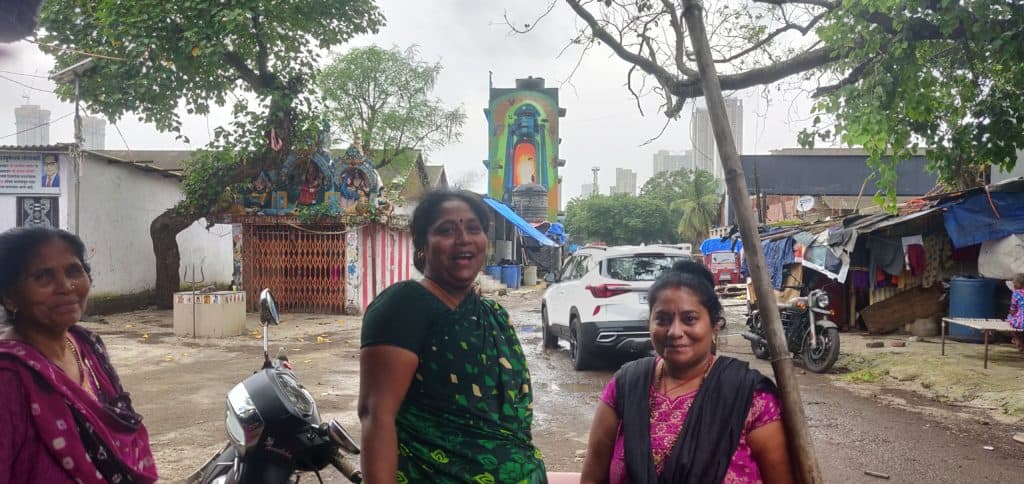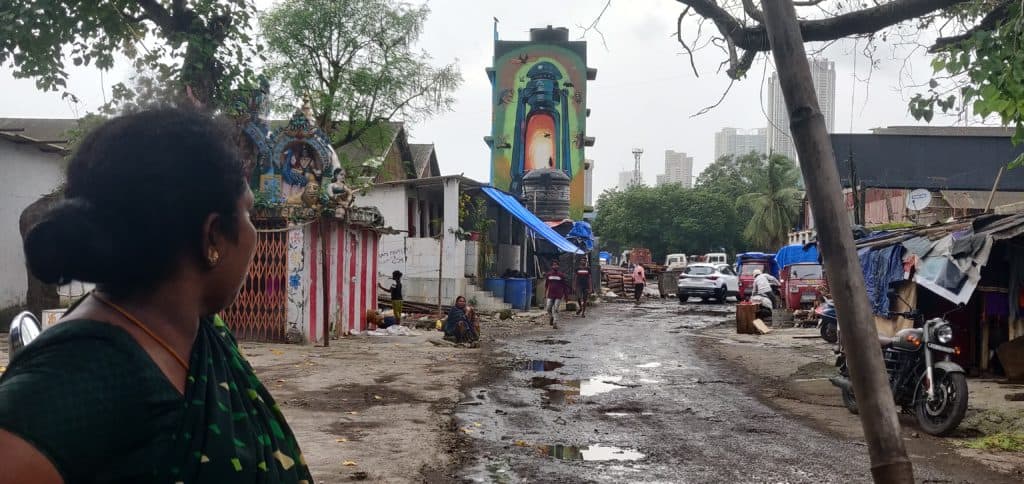For over a decade now, residents of Indira Nagar slums in Mumbai’s Sewree have been waiting for a road that would not be an invitation to diseases in their homes. But that has not happened yet. With the arrival of the monsoon, the road adjoining their makeshift houses gets waterlogged making their living conditions difficult and threatening public health.
“The water and mud accumulate when it rains heavily, even taxis don’t come here. People here frequently fall sick in the rains. There have been so many people who have had dengue or malaria in the past,” said 42-year-old Laxmi Harijan, who is a support staff at Nair hospital and has been living in the Indira Nagar slums all her life.
The area comes under Brihanmumbai Municipal Corporation (BMC)’s F southward, which reported the highest cases of malaria in BMC-run dispensaries over the past 10 years. “You know how it is in BMC hospitals, it consumes a lot of time and when we are sick going pillar to post along with our children can be even more exhausting. People in this area mostly visit small private clinics, unless the condition requires more treatment, then we go to BMC hospitals,” Harijan said.
Her neighbour, Soni Agrahari, said that BMC staff routinely visits the area and distributes medicines for common cold and fever. “There are also people who come to fumigate here. The last time they visited was in June, now they will probably come only after the rains end,” she said.

Diseases rise and threaten public health
With monsoons in Mumbai, vector-borne and water-borne diseases such as dengue, malaria, leptospirosis, hepatitis, typhoid, chikungunya and acute gastroenteritis, rise. These diseases are preventable, yet the city reports some of them in thousands every year.
A 2021 study by BMC health officials, on the impact of the pandemic on monsoon diseases, concluded that in 2020 there was a decline in almost all monsoon-related diseases compared to earlier years. The sharpest decline was observed in cases of acute gastroenteritis with 8,076 cases in 2018 and 7,785 cases in 2019 to 2,549 cases in 2020 — a fall of 52.36%. There were 3,110 cases of acute gastroenteritis reported in 2021.
“For the first time in seven years, the number of acute gastroenteritis cases recorded in the city decreased. The absence of street vendors during the lockdown and focus on hygiene of fruits and vegetables seem to be the contributors for this fall in cases,” the study suggested.
It added that another contributing factor to the decrease in the numbers in 2020 was the consumption of boiled water and regular hand washing practices to curb the spread of COVID-19.
Notably, the study states there may have also been under-reporting of patients under the Integrated Disease Surveillance Program (IDSP)—as most of the available human resources were deputed and diverted towards pandemic-related activities—and this could have resulted in a lower reported number of cases in the year 2020.
The only disease that saw a marginal increase in 2020 was malaria. There were 5,036 cases of malaria reported in 2018 and 4,357 in 2019 and this rose to 5,007 cases in 2020. Malaria cases also showed a rise last year with a total of 5,193 cases.
There have been more than 340 cases of gastroenteritis in the first two weeks of July and a total of 543 cases in June. The city reported 234 malaria cases in May, which surged to 350 in June and 243 in the first two weeks of July.
Read more: For patients’ families from rural Maharashtra, Dharamshalas in Mumbai offer a community of care
BMC’s role in maintaining public health
As part of their overall monsoon preparedness drive, the civic body installed dewatering pumps and flood water holding tanks in areas that are prime waterlogging hotspots.
BMC’s Additional Commissioner Sanjeev Kumar said wherever dewatering pumps have been installed, the results are as per expectations. “But again, when it rains very heavily, there are some places where water will be there for some time,” he said.
Mumbai reported 11 cases of leptospirosis between July 1st to July 17th and the civic body had earlier warned that the cases may see a rise by the end of the month. “The rise in leptospirosis cases will depend on the rains. At present, the rains are not as heavy but let’s see in the coming days and we’ll respond to the situation accordingly,” said Kumar.
There were 218 cases of leptospirosis reported in 2018, 281 in 2019, 240 in 2020, and a total of 224 in 2021. Kumar added that with the exception of COVID-19, the kind of diseases observed during monsoon remain the same. “The pattern is the same for the last 7 to 8 years. We are fully prepared for it, we have kept roughly 1500 beds for it in different hospitals. Routine activities such as fogging are all going on so there won’t be any problem,” said Kumar.
In June, the civic body directed all hospitals under it to start fever Out Patient Departments (OPDs) anticipating a surge in monsoon-related ailments. “We started an additional ward and a specialised OPD which is functional beyond usual hours. We have also purchased all the required medicines,” KEM Hospital dean Dr Sangeeta Rawat said.

Every year, BMC carries out pre-monsoon and post-monsoon activities to mitigate the spread of monsoon-related diseases to protect public health, which primarily see a spike in waterlogged areas and slums every rainy season. According to the medical officer of L ward Ravindra Hange, cases have not risen much this year in the area under him, which has a large slum population, compared to the earlier years. He claimed that this is because the waterlogging situation this year is fairly under control.
“We are conducting regular health check-up camps, 12 to 13 at the moment. Community Health Volunteers, surveillance staff and ASHAs are distributing medicines throughout the ward with more concentration on slums,” he said.
War against mosquitoes
BMC carries out intensive pest control activities before and during monsoon in all the wards under it. Rajan Naringrekar, insecticide officer from BMC’s public health department said that during the rains, there is a “crusade” carried out against the Anopheles mosquito the moment his team receives a malaria case from a ward medical officer. He said that the crusade is undertaken if a case is reported in one particular building or a slum.
“It depends on the number of cases reported to the pest control officer of that ward. We work throughout the year because the mosquito life cycle is eight days. We also do weekly anti-larval programmes in the entire Mumbai. In terms of monsoon preparedness, our additional staff visit slum areas to remove breeding sites on the rooftops and in labour huts at building construction sites,” said Naringrekar.
He added that mosquitoes largely breed in clean, accumulated water and not contaminated water. “Accumulation or stagnation of clean water is the only concern for malaria and dengue. In slum areas, there are drums of large capacity where water is stored which need to be covered properly. Even tarpaulin that is put on the rooftops can hold water and be breeding ground,” he said and added that the two vector-borne diseases are largely preventable by the public through precaution.
Out of the total 35 malaria cases reported in the F South ward later this month, 54% of the cases were diagnosed amongst people staying on the footpath outside hospitals such as Tata Memorial and KEM.
Deprived communities around Mumbai and even parts of Maharashtra visit public hospitals in the city for affordable public health treatment, and relatives of such patients end up sleeping either on adjoining footpaths or on the road within hospital premises.
Rawat said, “We have a provision of Visava for the relatives to stay where breakfast and a bed to sleep are provided at Rs 100. People should avail the facility, beyond that we can’t help.”
Another such facility in KEM is currently under construction. “We have also started free food for relatives of the patients. Breakfast and lunch are provided to one relative per patient,” Dr Sangeeta Rawat said.
Meanwhile, those like Harijan and Agrahari hope against hope for better access to health care and the prevention of diseases. “Anyone can shell out Rs 50 to Rs 100 at a private clinic but it becomes unaffordable when the cost goes above Rs 1,000,” Harijan said.
“We are poor people, we live in slums. From where will we shell out so much money? In the end, we have to knock on the doors of government hospitals and either die there or come out alive. We don’t have any other alternative to government hospitals for treatment,” she said.